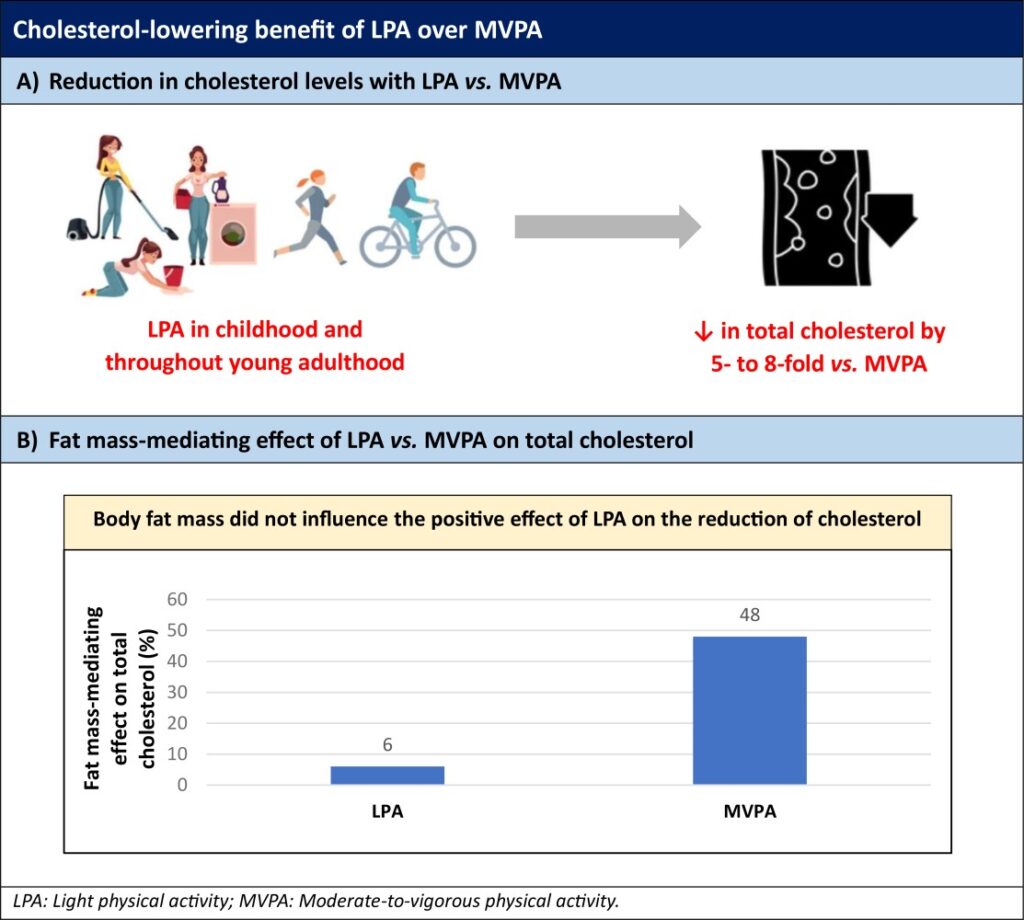
Elevated cholesterol and dyslipidemia in childhood have been linked with subclinical atherosclerosis and cardiac damage in the mid-twenties and premature death in the mid-forties. Long-term data on the association of accelerometer-measured sedentary time, light physical activity (LPA), and moderate-to-vigorous PA (MVPA) with lipid indices is limited among children. Moreover, there is a lack of clarity on the role of body composition and other metabolic indices in mediating the link between physical activity and changes in lipid levels, and whether poor movement behavior temporally precedes altered lipid levels.
A study by Agbaje recently published in “The Journal of Clinical Endocrinology & Metabolism”, reported that engaging in LPA for 3–4 hours/day in childhood and throughout young adulthood is an effective way to reduce the risk of elevated lipid levels caused by childhood sedentary time, in adulthood. The cholesterol levels were also reduced by MVPA, but its effect was diminished by body fat mass, whereas LPA was 5–8 times more effective in lowering cholesterol levels and was more resistant to the attenuating effect of fat mass compared to MVPA.
This 13-year long-term study included data from 792 children (mean age at baseline: 11.7 years; 58% female) who had at least 2 time-point measures of accelerometer-based sedentary time, LPA, and MVPA during 11-, 15-, and 24-year clinic visits along with complete fasting high-density lipoprotein cholesterol, triglyceride, and total cholesterol measures at ages 15, 17, and 24 years. The study investigated the associations of sedentary time, LPA, and MVPA with lipid indices, the mediating role of body composition, and whether time-based association exists between physical activity and lipid levels.
The study results are summarized below:
- There was an increase in sedentary time from ≈6 hours/day in childhood to 9 hours/day in young adulthood, which led to about 70% overall increase in the cholesterol levels. In addition, accumulated sedentary time from childhood led to 67% increase in total cholesterol, without any influence from body fat.
- A decrease in LPA from 6 hours/day in childhood to 3 hours/day in young adulthood was noted; it was associated with a cumulative reduction in total cholesterol.
- An increase in cumulative LPA was linked with reduced low-density lipoprotein cholesterol (LDL-C), triglyceride, and total cholesterol and the relationship was significantly mediated by fat mass, suggesting that LPA can decrease LDL-C and triglyceride by about 30% among children with obesity or high-body fat mass.
- Conversely, although MVPA remained stable at about 50 min/day, it was only associated with reduced total cholesterol.
- The strength of association of LPA with LDL-C, triglyceride, and total cholesterol was greater than that of MVPA (Graphic A).
- The mediating effect of body fat mass on the association between LPA and total cholesterol was lower than that noted with MVPA (Graphic B). The small effect of MVPA on total cholesterol was neutralized by increase in fat mass.

Clinical implications
- The study indicates that LPA is more feasible and accessible than MVPA, requiring less motivation, can be easily incorporated in daily routine, and not requiring a high level of skill/prior fitness, thus, making it a practical strategy for future interventions and public health guidelines for children to prevent the risk of cardiometabolic conditions.
- The study findings highlight the importance of addressing sedentary childhood behavior as it is a vital factor influencing long-term cardiac health.
- Public health experts, pediatricians, and health policymakers should encourage more participation in LPA from childhood to avoid elevated cholesterol levels later in life.
(Source: Agbaje AO. Associations of sedentary time and physical activity from childhood with lipids: A 13-year mediation and temporal study. J Clin Endocrinol Metab. 2023:dgad688. Doi: 10.1210/clinem/dgad688)
